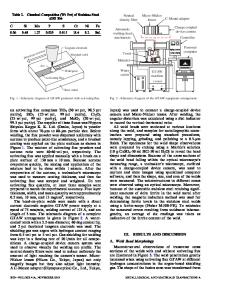Cavity microstructure and kinetics during gas tungsten arc welding of helium-containing stainless steel
- PDF / 5,311,619 Bytes
- 12 Pages / 594 x 774 pts Page_size
- 3 Downloads / 403 Views
INTRODUCTION
IT is well known that energetic neutron irradiation produces significant physical damage to crystalline solids by the displacement of atoms from their normal lattice sites, tL2] In addition, transmutation reactions generate foreign elements of which helium is known to induce intergranular embrittlement. [3,4.5]Degradation of material properties by these processes plays a decisive role in limiting the useful life of nuclear reactor components. It is reasonable, therefore, to anticipate that the repair and replacement of degraded reactor components will be required. Such repair procedures are likely to require the use of joining processes such as gas tungsten arc (GTA) welding. One of the critical issues in determining the postirradiation weldability of materials is the presence of entrapped helium. Helium is essentially insoluble in metals. Experimentally, its solubility has been reported to be 0.1 MeV). Intergranular cracking was observed by Hall et al. in the HAZs of a small fraction of these welds, which are estimated to have helium concentrations between 3 and 15 appm depending upon the fluences. Atkin tgj performed GTA welding of 20 pct cold-worked (CW) 316 stainless steel irradiated in the EBR-II at approximately 400 ~ to a peak fluence of 12.6 • 1026 n/m 2(E > 0.1 MeV). These welds, which were made in an unconstrained condition, were then bend tested. Preliminary examinations indicated that the welds were sound and free from cracks. Knowing the irradiation conditions and helium generation rates obtained in similar experiments, we have calculated the helium content to be between 4 and 25 appm. Atkin concluded that weld zone properties of 20 pct CW 316 stainless steel were not severely degraded by the precipitation of helium. However, no further results have been reported. Some recent results involving the repair of stress corrosion cracks in an irradiated stainless steel reactor tank have been reported, tt~ The helium content of the reactor tank material was measured to be approximately 3 appm. Patches were GTA welded over the regions containing stress corrosion cracks. Subsequent examination revealed extensive cracking in the HAZ of the patch welds. The obviously hostile environment and radiological hazards associated with welding irradiated materials have limited the scope of previous investigations. As a result, a quantitative understanding of the relationship between helium and weld cracking has not been developed. The objective of the present study was to provide a better understanding of the mechanisms and kinetics of processes which govern bubble growth during the welding of helium-bearing materials. To avoid the difficulties involved with hot cell operations and reduce the radiological hazards, helium was introduced into type 316 stainless steel by tritium charging the test material and allowing the tritium to decay to 3He prior to welding. In
U.S. GOVERNMENT WORK NOT PROTECTED BY U.S. COPYRIGHT
VOLUME 21A, SEPTEMBER 1990--2585
this way, it was possible to evaluate the principal effec
Data Loading...











